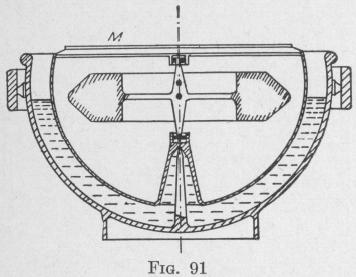116 THE GYROSCOPIC PENDULUM
From the data for any star as given in the Nautical Almanac, together with the observed altitude at any known time not too remote from the time of crossing the meridian, the latitude of the observer can be computed.
72. Gyro-Horizons. -The latitude of a place is determined from the altitude of a celestial body. For the measurement of the altitude of a celestial body we must have a horizontal surface of reference. The horizon plane is the most convenient reference plane when the horizon is visible. On land we could use also the free surface of an unaccelerated liquid, or a plane normal to an unaccelerated plumb-bob. On a ship at sea neither of the two latter devices is available because each is subject to any force that accelerates the motion of the ship, such as the forces that produce rolling, pitching, or a change in either speed or course.
These forces produce less effect on the direction of the spinaxle of a gyro-pendulum that is normally vertical than upon the direction of either a liquid surface or a plumb-bob. A single impulse deflects the spin-axle in the direction of the force to a slight extent and it also produces a motion of precession having a definite period. If the period of precession of the spin-axle is great compared with the period of the accelerative forces producing rolling or pitching, the effect of the alternating impulses during a complete period of precession will be nearly neutralized. If the period of precession is not less than one hour, the deflection of the spin-axle of a gyro-pendulum from the vertical, produced by rolling or pitching of the ship, will be very small. This small error due to precession is eliminated almost completely by using the mean position of the spin-axle at instants separated by a half period of precession. For this procedure it is desirable that the period of precession be as small as possible. The required long period is secured by mounting the gyro so that the center of gravity of the precessing system is at a short distance below the point of support (Art. 68). The desired short interval between two instants separated by a half period requires that the center of gravity of the precessing system be at a great distance below the point of support.
The first gyro-horizon was made in the middle of the eighteenth century by an English instrument-maker named Serson. It consisted of a thick disk balanced at a point above its center of mass and capable of spinning on the upper end of a vertical pin. When the disk was maintained in rapid rotation, the spin-axis quickly assumed a practically vertical position and the upper polished sur
GYRO-HORIZONTALS AND GYRO-VERTICALS 117
face of the disk became practically horizontal. It was proposed that this surface be used as a base from which to measure the altitude of heavenly bodies when the horizon is obscured by clouds or haze. The apparatus was tested on a British warship but, unfortunately, the ship went down and both the instrument and the inventor were lost. Since that time, gyroscopic horizons Dave received little attention till quite recently.
73. The Schuler Gyro-Horizon. - This instrument* consists of a gyro mounted in a spherical bowl that floats in a vessel of liquid contained in an outer bowl, Fig. 91. The inner bowl is
kept centered by a pointed rod extending upward from the bottom of the outer bowl. The outer bowl is carried on gimbals. A plane mirror M is normal to the spin-axle. The center of gravity of the gyro with the inner bowl is at such a distance below the center of buoyancy that the period of precession of the spin-axle is about 85 minutes.
74. The Anschutz Gyro-Horizon. - This instrumentt has a mirror M, Fig. 92, mounted on a gyro-casing supported on gimbals, the axes of which are at different levels above the center of gravity of the gyro and casing. Normally, the spin-axle is vertical. The housing carrying the gimbal axes can be turned in azimuth till the gimbal axis AA nearer the center of gravity of the gyro and casing is in line with the heavenly body under observation. As forces acting at the center of gravity and producing torques about the axis AA nearer the center of gravity have a short lever arm, the precession which they produce about the other gimbal axis BB is small. Consequently, the torque produces
* U. S. Patents. Schuler, No. 1480637, 1924; t U. S. Patent. Anschutz, No. 1141099. 1915
